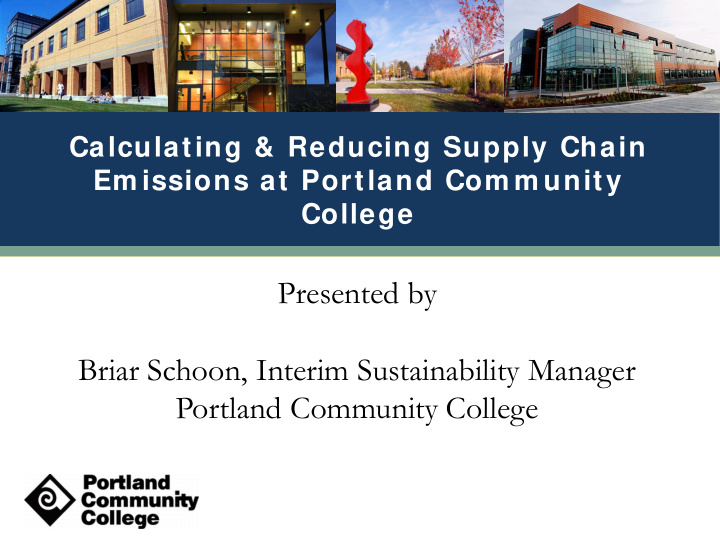



Calculating & Reducing Supply Chain Em issions at Portland Com m unity College Presented by Briar Schoon, Interim Sustainability Manager Portland Community College
About PCC • Largest higher educational institution in the state of Oregon • PCC has 10 campuses and centers throughout the Portland- metro area • Approximately 90,000+ students • 3205 staff and faculty members • Collectively, our square footage combined is slightly larger than the state of Rhode Island.
PCC GHG Targets • Reduce emissions from 2006 levels: – 10% by 2012; – 40% by 2030; and – 80% by 2050
GHG Calculator Good Company's G3C calculator
Supply Chain Emissions The scale of greenhouse gas emissions from supply chain can be quite large.
Supply Chain Methodology 1) Collect the necessary purchasing data
Supply Chain Methodology 2) Organize the data via the internal accounting codes provided from purchasing.
Supply Chain Methodology 3) Remove the account categories that either represent double- counting (such as electricity and solid waste) or that are not for goods and services such as salaries.
Supply Chain Methodology 4) Group data into 15-20 major categories
Supply Chain Methodology 5) Utilize the Economic Input-Output Life Cycle Assessment (EIO-LCA) method to find the CO 2 e-intensity for each of those categories. The EIO-LCA online tool is available for free and assists in converting economic activity through dollars spent into GHG emissions. The tool and more information about it can be found at the following website: http://www.eiolca.net
The EIO-LCA tool
Supply Chain Methodology 6) Adjust the results for inflation using the U.S. Department of Labor – Bureau of Labor Statistics (BLS), Consumer Price Index (CPI). When using the EIO-LCA tool, you must adjust for inflation because it is based on 2002 prices
Supply Chain Methodology 7) Enter your adjusted emissions intensities into the calculator you are using for your inventory.
Moving Forward • Two questions: – How to promote sustainable purchases in a complex and diverse organization like PCC? – How to account for sustainable purchases in GHG inventory?
Moving Forward More specific supply chain GHG inventory • Emission intensities specific to Oregon- consumption patterns • Developed by David Allaway with Oregon DEQ • Three-region consumption model
Moving Forward • Working with admins to promote EPP • Product-specific Green Office Supplies Purchasing Guide
Moving Forward • Working with Office Max to highlight green products & track purchases • Plan to use EPA’s ReCon tool to identify GHG savings from recycled content purchases.
Moving Forward • Sustainability language and criteria in RFPs and college-wide contracts – Successfully modeled for the first time in our waste hauling invitation to bid last month – Infused sustainability throughout ITB – About 30% of award criteria
Moving Forward • Sustainable purchasing with the District Student Council – 2 nd largest purchaser at PCC – Drafted policy & criteria with students – Plans to develop product & service-specific sustainable purchasing guide – To be implemented next academic year
Moving Forward • Working with organizations focused on sustainable procurement – Sustainable Purchasing Leadership Council – West Coast Government Purchasing for Climate Protection Workgroup – Healthy Purchasing Coalition in OR
Challenges • Looking for strategies and solutions to address: – Measuring success – Calculating GHG savings associated with sustainable purchases/products
Questions? • Thank you! • Briar Schoon, Interim Sustainability Manager Briar.schoon@pcc.edu 971-722-8322
Recommend
More recommend